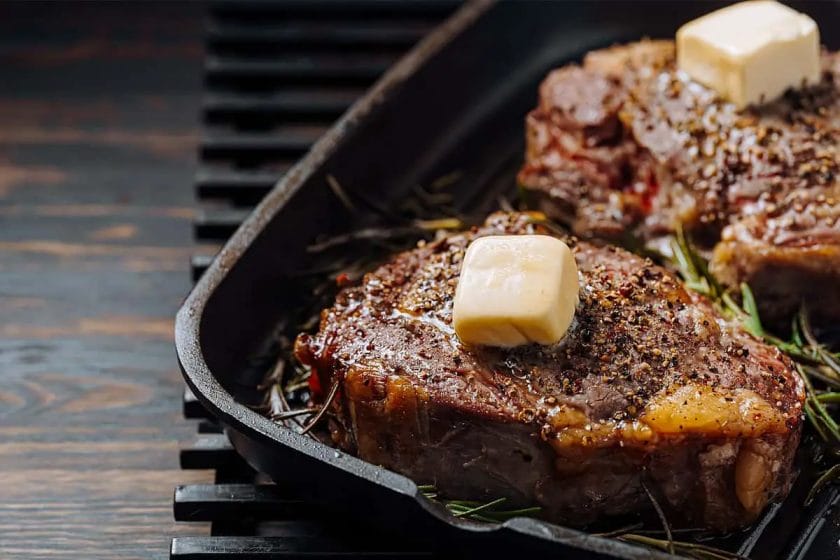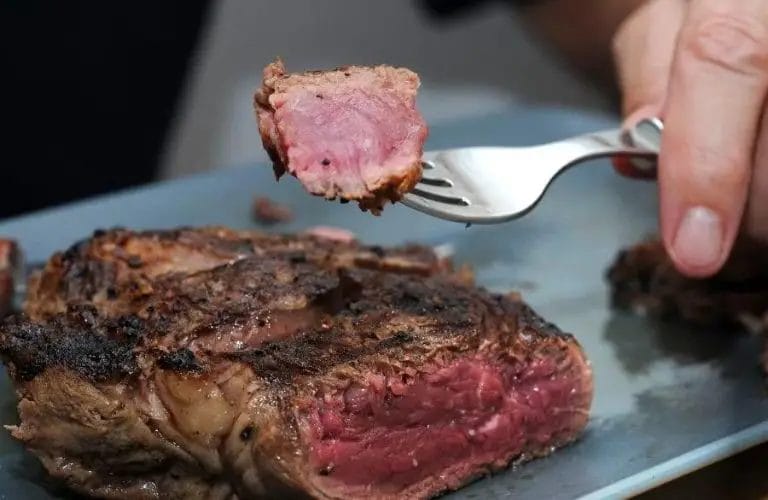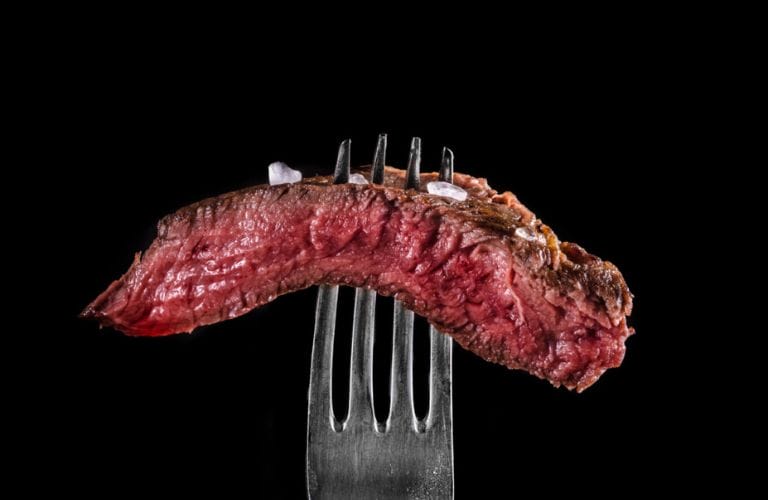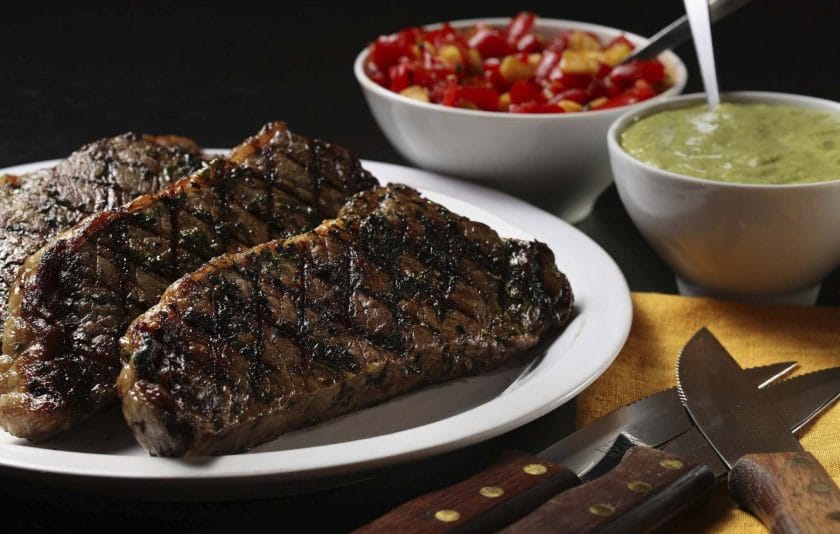Curious about how long it takes for your body to digest steak? The digestion process varies depending on several factors, such as the cooking method and the individual’s metabolism. However, on average, it can take around 2 to 6 hours for your body to fully digest a steak.
The high protein content and dense texture of steak may slow down digestion compared to other types of food. Ultimately, the digestion time can differ from person to person, so it’s essential to listen to your body’s signals and eat according to your own digestive capacity.

Digestion process of steak: Understanding the journey in your body
When you sit down to enjoy a delicious steak, you probably don’t spend much time thinking about what happens to it after you swallow.
However, the digestion process is a fascinating journey that takes place in your body, breaking down the steak into nutrients that can be absorbed and used by your cells. In this section, we will explore the step-by-step process of how your body digests and absorbs the nutrients from a steak.
Chewing: The first step in digestion
The digestion process of a steak begins in your mouth, where the mechanical breakdown of food starts. As you take a bite of steak, your teeth tear and grind it into smaller pieces, increasing the surface area for enzymes to act upon.
Saliva, which contains enzymes like amylase and lipase, is also mixed with the steak, initiating the chemical breakdown of carbohydrates and fats.
Swallowing: Passing the chewed food down the esophagus
Once you have chewed the steak into small enough pieces, you swallow it. The chewed food then travels down the esophagus, a muscular tube that connects your mouth to your stomach. The process of swallowing is facilitated by the muscular contractions called peristalsis.
Stomach: Breaking down the steak further
As the steak reaches your stomach, it encounters an acidic environment. The stomach lining secretes hydrochloric acid and enzymes, such as pepsin, which further break down the proteins in the steak.
The stomach muscles contract and mix the steak with gastric juices, forming a semi-liquid substance called chyme.
Small intestine: Absorbing the nutrients
After leaving the stomach, the chyme enters the small intestine, where most of the digestion and absorption of nutrients takes place. The small intestine is around 20 feet long and has specialized structures called villi and microvilli, which increase its surface area for nutrient absorption.
Here, the steak is broken down into smaller molecules by enzymes produced by the pancreas and small intestine itself. Proteins are broken down into amino acids, fats into fatty acids and glycerol, and carbohydrates into simple sugars.
The nutrients are then absorbed through the villi and microvilli and enter the bloodstream, which carries them to different parts of your body to be used for energy, growth, and repair.
Large intestine: Eliminating waste
After the small intestine has absorbed all the nutrients it can from the steak, the remaining waste, along with water and electrolytes, moves into the large intestine. The main function of the large intestine is to absorb water and electrolytes and form solid waste, known as feces.
The feces are then stored in the rectum until they are eliminated from the body through the anus in the process called defecation.
Factors Affecting Steak Digestion Time: What to Consider for Faster Digestion
When enjoying a delicious steak meal, the last thing you want is to feel bloated and uncomfortable for hours after eating. The speed at which your body digests steak can vary depending on several factors.
By understanding these factors and making the right choices, you can help optimize your digestion and enjoy your steak without any discomfort. In this section, we will explore the key factors that affect steak digestion time and provide tips for faster digestion.
1. Cut of Steak
The type of steak you choose can have a significant impact on digestion time. Different cuts of steak have varying levels of tenderness and fat content, which can affect how quickly they break down in the stomach.
Generally, leaner cuts like filet mignon or sirloin tend to digest faster compared to fattier cuts like ribeye or T-bone.
2. Marbling and Fat Content
The marbling, or the distribution of fat within the meat, affects both the flavor and digestion time of steak. While fat adds flavor and juiciness to the meat, it can also slow down digestion. Opting for steaks with less marbling and trimming excess fat before cooking can help promote faster digestion.
3. Cooking Method
The way you cook your steak can impact how easily it gets digested. Overcooking steak can make it tougher and more challenging for your stomach to break down.
It is best to cook steak to your desired doneness, ensuring it is still tender and easy to chew. Grilling, broiling, or baking are cooking methods that can help preserve the tenderness and promote efficient digestion.
4. Seasonings and Marinades
The choice of seasonings and marinades can influence both the taste and digestion of steak.
Some seasonings and marinades may contain ingredients that can slow down digestion or cause discomfort, such as excessive sodium or spices. Opt for lighter and simpler seasonings to minimize any digestive issues and promote faster digestion.
5. Portion Size
The amount of steak you consume in one sitting can also affect digestion time. Larger portion sizes require more time and energy for your stomach to break down. Consider reducing the serving size and complementing your meal with a variety of vegetables or a salad to aid digestion.
6. Eating Habits
How you eat your steak can impact digestion as well. Eating too quickly or not chewing your food thoroughly can put additional strain on your digestive system.
Take your time to chew each bite thoroughly and savor the flavors. This will help break down the steak more effectively in your stomach, leading to faster digestion.
7. Individual Factors
It is important to keep in mind that each person’s digestive system is unique. Factors such as age, metabolism, and any underlying digestive conditions can influence the speed at which steak is digested. Pay attention to how your body reacts to different types of steak and adjust your choices accordingly.

Tips to Improve Steak Digestion: Making it Easier on Your Digestive System
Steak is a delicious and nutritious protein source that many people enjoy. However, some individuals may experience digestive issues when consuming steak, such as bloating, gas, or discomfort.
If you’re one of those people, don’t worry! There are several tips and strategies you can follow to improve steak digestion and make it easier on your digestive system.
Eat Smaller Portions
One of the first tips to improve steak digestion is to cut your portions into smaller sizes. Eating smaller pieces of steak can help your digestive system better break down the food and process it more efficiently.
Instead of consuming one large steak, opt for smaller cuts or share a steak with a friend or family member.
Chew Thoroughly
The process of digestion begins in your mouth, so it’s essential to chew your steak thoroughly before swallowing.
Chewing breaks down the food into smaller pieces, allowing your stomach and intestines to process it more effectively. This also helps to ease the overall workload on your digestive system.
Marinate the Steak
Marinating steak before cooking can have multiple benefits. It not only enhances the flavor but also helps to tenderize the meat.
Additionally, certain marinades, such as those containing acidic ingredients like lemon juice or vinegar, can help break down the protein in the steak, making it easier to digest.
Choose Lean Cuts
Opting for lean cuts of steak can also improve digestion. Lean cuts have less fat content, which can be more challenging for the body to break down and digest. Look for cuts like sirloin, tenderloin, or flank steak which are leaner options compared to ribeye or T-bone steaks.
Pair with Digestive Enzymes
If you frequently experience digestive issues when consuming steak, you might consider taking digestive enzyme supplements.
These supplements contain enzymes like protease, which helps to break down proteins, including those found in steak. Taking them before or during your meal can aid in digestion and alleviate discomfort.
Include Fiber in Your Meal
Fiber plays a crucial role in promoting healthy digestion. Including fiber-rich foods alongside your steak can help improve digestion. Vegetables, whole grains, and legumes are great options. Fiber adds bulk to your stool and helps move it through your digestive system more efficiently.
Avoid Overcooking
Overcooking steak can make it tougher and harder to digest. It’s important to cook your steak to your desired level of doneness, but avoid overcooking it. Medium-rare or medium steaks are often easier to digest than well-done steaks.
Stay Hydrated
Drinking enough water throughout the day is essential for overall digestion, including steak digestion. Water helps to break down food in your stomach and keeps your digestive system running smoothly. Make sure to drink an adequate amount of water, especially when consuming a protein-rich meal like steak.
Listen to Your Body
Every person is different, so it’s important to listen to your body and pay attention to how it reacts to steak or any other food.
If you consistently experience digestive issues after consuming steak, it may be beneficial to consult with a healthcare professional or a registered dietitian to identify any underlying digestive conditions or to receive personalized guidance.

Potential Digestive Issues with Steak: How to Avoid Discomfort
Steak is a popular choice for meat lovers around the world. It’s juicy, flavorful, and can be cooked to perfection. However, some people may experience digestive issues after consuming steak.
In this section, we will explore the potential digestive problems that may arise from eating steak and provide tips on how to avoid discomfort.
1. Acid reflux
Acid reflux, also known as gastroesophageal reflux disease (GERD), is a condition where stomach acid flows back into the esophagus. This can cause a burning sensation in the chest, known as heartburn. Consuming fatty foods like steak can trigger acid reflux in susceptible individuals.
To avoid acid reflux when eating steak, consider the following tips:
- Choose lean cuts of steak: Opt for lean cuts of steak, such as sirloin or tenderloin, that have less fat content. Trim visible fat before cooking to reduce the risk of acid reflux.
- Avoid heavy seasoning: Spicy or heavily seasoned steaks may worsen acid reflux symptoms. Stick to milder seasonings or marinate the steak with herbs and vinegar instead.
- Smaller portion sizes: Overeating can exacerbate acid reflux. Enjoy a moderate portion of steak and pair it with lighter side dishes.
- Take your time when eating: Eating slowly and chewing your food thoroughly can aid in digestion and reduce the likelihood of acid reflux.
2. Constipation
Constipation is a common digestive issue characterized by infrequent bowel movements and difficulty passing stool. While steak itself is not a direct cause of constipation, certain factors related to steak consumption can contribute to this problem.
To prevent constipation when consuming steak, try the following recommendations:
- Include fiber-rich foods: Pair your steak with high-fiber foods like leafy greens, whole grains, and legumes. Fiber promotes regular bowel movements and helps prevent constipation.
- Stay hydrated: Drink an adequate amount of water throughout the day to keep your stools soft and easier to pass.
- Exercise regularly: Engaging in physical activity can stimulate bowel movements and reduce the risk of constipation.
- Consider cooking methods: Grilling or broiling steak is a healthier option compared to frying, as excessive consumption of fried foods can contribute to constipation.
3. Foodborne illnesses
Foodborne illnesses are a concern when consuming undercooked or contaminated meat, including steak. Bacteria such as E. coli and Salmonella can cause symptoms like nausea, vomiting, diarrhea, and abdominal pain.
To minimize the risk of foodborne illnesses from steak, follow these safety measures:
- Cook steak to the recommended temperature: Use a food thermometer to ensure the internal temperature of the steak reaches 145°F (63°C) for medium-rare, 160°F (71°C) for medium, or 165°F (74°C) for well-done.
- Practice good hygiene: Wash your hands thoroughly before and after handling raw steak. Avoid cross-contamination by using separate utensils and cutting boards for raw and cooked foods.
- Proper storage: Refrigerate raw steak promptly and consume it within a few days to prevent bacterial growth.
Balancing Steak Consumption: Finding the Right Portion for Efficient Digestion
Steak is a beloved food for many meat lovers around the world. Its rich flavor and juicy tenderness make it a popular choice for carnivores. However, consuming steak in excessive amounts can lead to digestive issues and other health problems.
In this section, we will explore the importance of balancing steak consumption and finding the right portion size for efficient digestion.
The Importance of Portion Control
Portion control plays a vital role in maintaining a healthy diet. When it comes to steak, it’s crucial to strike a balance between indulging in its deliciousness and ensuring that we don’t overwhelm our digestive system.
Overeating steak can put excessive strain on our digestive organs, leading to discomfort, bloating, and even indigestion.
By practicing portion control, we can enjoy steak while still supporting optimal digestion. It allows our bodies to break down and absorb nutrients efficiently, promoting overall well-being.
Determining the Right Portion Size
So, how do we determine the right portion size of steak for efficient digestion? Here are some guidelines to help you find the perfect balance:
- Consider your activity level: The amount of steak you consume should be based on your activity level and energy needs. If you have a sedentary lifestyle, a smaller portion might be more appropriate. However, if you’re physically active, you may require a slightly larger portion to meet your energy demands.
- Listen to your body: Pay attention to your body’s hunger and satiety cues. Eat until you feel comfortably satisfied, rather than stuffing yourself with excessive amounts of steak. It’s important to give your body time to signal when it’s had enough.
- Choose lean cuts: Opt for leaner cuts of steak, which are lower in saturated fat. This not only promotes heart health but also makes digestion easier. Lean cuts include sirloin, tenderloin, and flank steak.
- Pair with fiber-rich foods: Balancing your steak consumption with fiber-rich foods, such as vegetables and whole grains, can aid digestion. Fiber adds bulk to your meals, promoting regular bowel movements and preventing constipation.
The Role of Cooking Methods
How you cook your steak can also impact its digestibility. Here are a few tips to make your steak more easily digestible:
- Don’t overcook: Overcooking steak can make it tougher and harder to digest. Cook your steak to your preferred level of doneness, but try not to overdo it.
- Marinate your steak: Marinating steak before cooking can help tenderize the meat, making it easier to chew and digest.
- Allow for proper resting time: Let your steak rest after cooking to allow the juices to redistribute. This helps maintain its juiciness and enhances digestion.

FAQs
How long does steak take to digest?
The digestion time for steak varies depending on factors such as the individual’s metabolism and the size of the steak. On average, it takes about 2-6 hours to digest a normal-sized steak. However, it can take longer if the steak is larger or if the person has a slower metabolism.
Conclusion
In conclusion, the digestion time of steak varies from person to person. Factors such as the individual’s metabolism, the cooking method, and the cut of the steak can influence the duration of digestion. Generally, it takes around 4 to 6 hours for the stomach to fully break down steak.
However, the digestion process continues in the small intestine, where the nutrients are absorbed into the bloodstream. It is important to note that a healthy digestive system plays a significant role in efficient digestion.
To support digestion, it is advisable to chew steak thoroughly, maintain a balanced diet, and stay hydrated.

